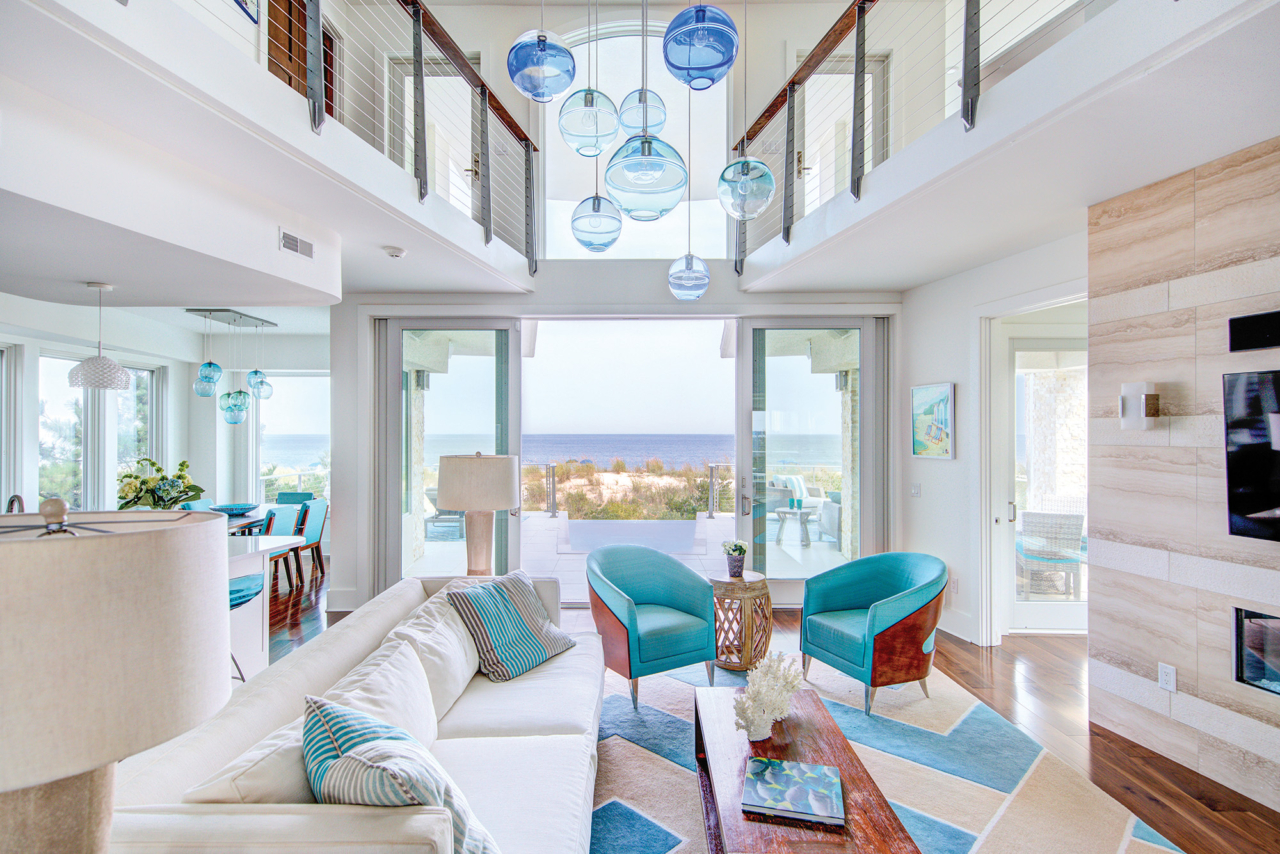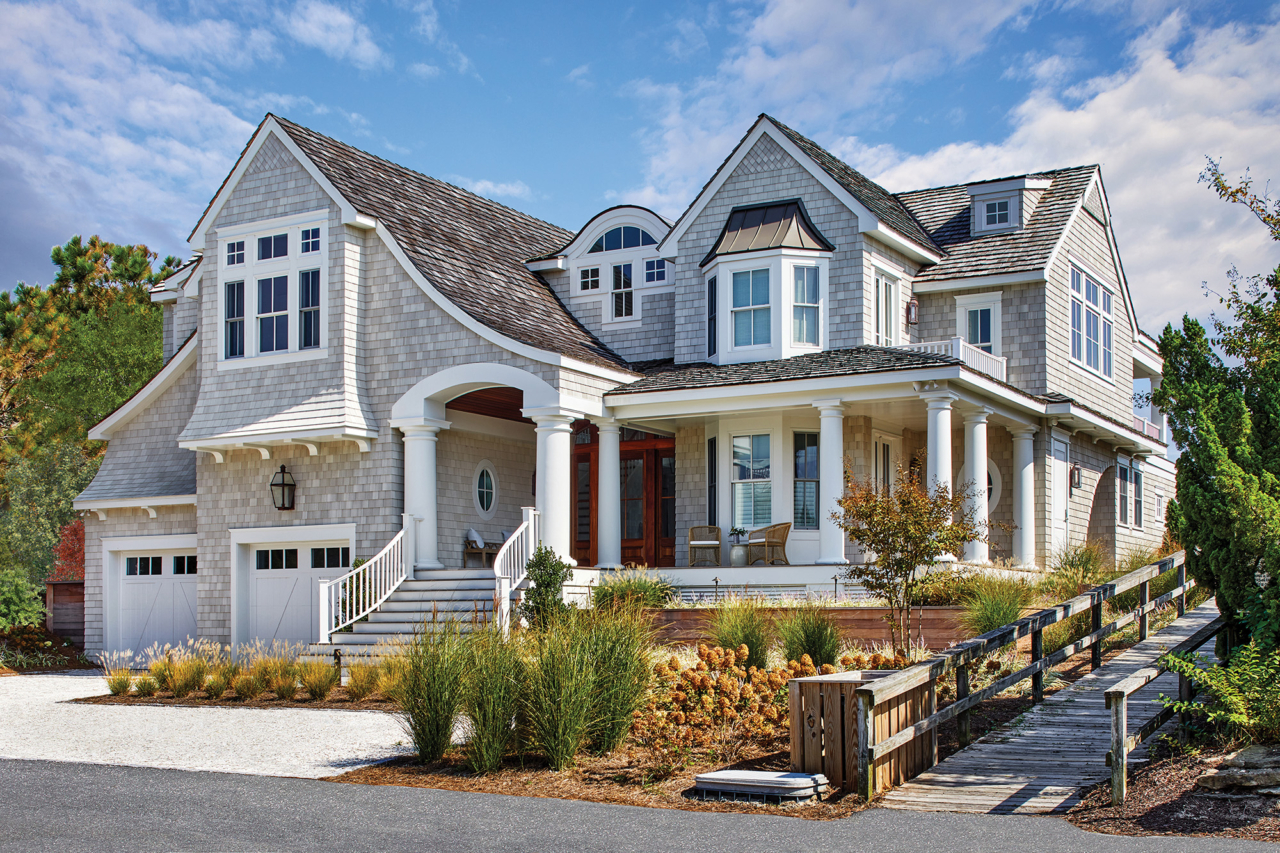No need to feel overwhelmed. Experienced architects and designers can guide the decision-making process during custom home construction and renovation.
Written by Kristen Hampshire
Decisions, decisions—so many of them to navigate during home construction or renovation. Making the decision to do the project in the first place and engage in a custom architect and designer is just the beginning.
Type “coastal architecture” into Google “and your head will spin,” relates Christopher L. Pattey, Assoc. AIA, of Becker Morgan Group in Salisbury. But he always encourages this search, noting that offering a professional a plethora of preferences allows an architect to cull down the options by identifying common threads and themes.
Showing inspo pictures rather than describing what you like and what’s a no-thank-you can be a more effective way to launch a discussion. “These jumping off points are one aspect—and then we focus on practical considerations,” Pattey says, explaining that design decisions are lifestyle-driven.
“My approach to the best overall design ethos is to conceive the entire project as a master plan for continuity,” Pattey says.
Specifically, site-specific designs require planning the layout and orientation of a home, including outdoor living spaces and site amenities. Furniture should be curated to align with the flow of a floorplan, he says.
THE RIGHT ARCHITECT: MY THREE “R’s”
When selecting a custom builder and architect, Christopher Pattey, a Worcester County native with more than 35 years of architectural experience, says he relies on the “3 Rs” — referrals, repeats and reputation.
Referrals
Talk to homeowners who have enlisted in the builder you’re considering. Tour homes various builders have constructed. “See their work in person—their craftsmanship,” Pattey advises. “Talk to their customers, and meet custom architects in person because this is a marriage for a period of time. You have to be as happy with the personality as with the quality and price—it’s a tripod.”
Repeats
When an architect and a custom builder wins repeat business from clients, this loyalty signals a trusting relationship and appreciation of a job well done.
Reputation
Years of experience is important for large-scale custom home design projects. So is your architect and builder’s understanding of the community and environment where you are choosing to develop a home. Pattey also emphasizes, “Architecture and interior design are integral and should be cohesive.” The most successful projects involve an aligned team from conception to final walk-through—and beyond.

“Through careful coaching, designers can steer the way through the endless possibilities,” Pattey assures. Here, he offers a practical approach for well-planned, thoughtful selections.
All In or Hands Off?
How involved do you want to be in the process?
Do you have time to devote to making every decision, overseeing every detail? Most do not. “Some people want a hybrid approach where they want to make some selections on their own and rely on a qualified custom builder who understands their vision to take it from there,” Pattey says.
Flexibility is important. Go with a builder/architect who will accommodate as much or as little of your involvement as you choose. There are many ways to approach interiors selections, all at the owner’s comfort level, he emphasizes. “The design process starts with discussing their desires, expectations and the design budget for fees and products,” Pattey says.
Some questions Pattey asks:
• Do you wish to make your own selections?
• Do you want a builder’s selections professional to work with you to perform these tasks
as part of the design-build process?
• Do you want the architect to suggest finishes or serve as a sounding board?
• Will you hire an independent interior design consultant as part of a design-build team?
• Will you bring existing furniture that must be incorporated into the new design?
Ins and Outs
Often, selections start with a theme, color or material the client deems as a must-have. “Is the style eclectic? Do they prefer blues or greens? Do they lean toward modern or traditional styles?” Pattey relates.
“Design is so very personal, and the designer must ‘get’ their clients so that their personality is captured,” Pattey adds, explaining that he avoids contrived looks such as a matchy-matchy furniture set that looks as if it were transplanted from a showroom.
“Eclecticism usually has the best feel when done well and not hodge-podge,” he adds. “Timeless with a twist vs. super trendy always gets my vote. But, let’s face it, styles do have popularity based on current and evolving trends, and after all, the homeowner should be happy.”

Oftentimes, there is a disconnect between the price tag on inspirational photos pulled from Pinterest and the actual budget. “With the barrage of resources, we help narrow down selections to help identify what will suit the environment, their lifestyle, aesthetic and budget,” Pattey says.
Pattey scrolls through some main decision-making points and offers this insight for guiding the process.
Exterior: Consider aesthetics, the environment—exposure to the elements—the style of surrounding homes and maintenance. “We educate clients on longevity, new products and performance based on our experience,” Pattey says. For instance, Ipe (Brazilian Walnut) ages and resists rotting, along with being bug resistant. PVC materials also stand up to tough environments, even though I tend to be a purist.
Interior: Environment is important for interior selections, too. For instance, in high-humidity locations, wide plank flooring can “cup” and an engineered floor with a stable substrate will not bow, Pattey explains.
As for surfaces such as countertops, functionality is just as important as aesthetics, Pattey says. “If you want a marble look in a high-traffic kitchen, quartzite is more durable and can mimic the look and quartz, which is man-made, offers consistent veining at varied price points for all budgets.”
For some, the kitchen is a showplace. For others, it’s a mess hall.
“You have to think about who is going to use the space,” Pattey says. This recommendation applies to every room in a home.
Color can be an overwhelming decision. “Start with something you really love in a room—something that speaks to you that will spin off decision-making,” Pattey advises. “A personal inspiration item, a unique piece of tile or artwork.”
Finally, a word on going with your gut.
“Custom unique homes should not fit the mold of a boring beige flip for the next buyer,” Pattey says. Though, if neutral is your preference, “Don’t hesitate,” he adds. “Also, don’t be afraid to explore possibilities.”
Most of all, “Design for yourself, not in anticipation of what someone else would want,” Pattey advises. “Bringing joy to your life is what matters. It’s where your family experiences life!” CS
